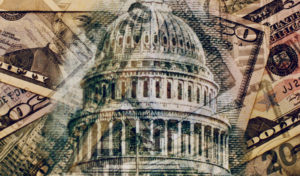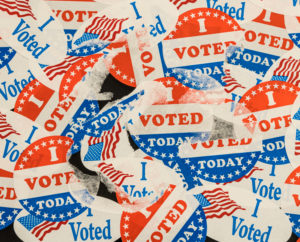
The FEC’s data system must be improved if campaign finance disclosure is to work.
Earlier this spring, the Supreme Court delivered yet another blow to campaign finance regulation. In McCutcheon v. FEC, the Court invalidated the federal “aggregate limits” —or statutory restrictions on the amount any single individual can contribute to all federal candidates, parties, and committees combined. This decision was the latest in a string of decisions handed down by the Roberts Court removing restrictions on the flow of money into politics.
McCutcheon is likely to drive significantly more money into the coffers of federal candidates, political parties, and other political committees. While the overall limit on the amount any individual could donate to such entities in a single election cycle was $123,200 prior to McCutcheon, wealthy individuals may now be able to contribute over $3.5 million in a single cycle.
Much of the post-McCutcheon commentary has focused on the decision’s likely impact on the “base limits” that continue to cap contributions to individual campaigns, political parties, and other political committees. On its face, the decision left the base limits untouched. The majority skirted the issue—at least for now.
But less noted in the aftermath of McCutcheon was the fact that the Court went out of its way to affirm the constitutionality of campaign finance disclosure. The Chief Justice’s opinion asserted that disclosure “offers a particularly effective means of arming the voting public with information” and in addition provides “robust protections against corruption.” Indeed, every member of the current Court but Justice Thomas has now signaled strong approval of disclosure.
In light of such support from the Supreme Court, disclosure appears to be on firm constitutional footing. But is the Court right about the effectiveness of disclosure? Does disclosure about campaign financing actually arm the public with the information needed to make informed choices and hold candidates and elected officials accountable?
We question the view that the system of disclosure—at least as it is presently constituted—is able to effectively advance the interests the Court has identified in the campaign finance sphere. Instead, we argue that the way campaign finance information is collected, maintained, and disseminated by the Federal Election Commission (FEC) is in need of serious improvement before disclosure stands a chance of matching Chief Justice Roberts’ rhetoric.
Although media accounts in recent elections have focused on shadowy super-PAC and nonprofit donors, the bulk of money in American elections still flows directly from private donors to the campaign coffers of political candidates. All of this money—which will almost certainly increase in light of McCutcheon—is subject to disclosure under a system that is in theory quite robust. But the current disclosure regime suffers from a number of limitations that impede the interested electorate’s ability to understand who is financing American elections, and to what potential ends.
Since the late 1970s, federal law has required individual donors to report their first and last names, occupation/employer, and address with a contribution over $200. Despite this requirement, FEC records are plagued with a series of problems: selective compliance (i.e., donors who do not uniformly comply with disclosure requirements), valid nonresponse (i.e., donors who supply information that is vague), and dissimulation (i.e., donors who supply misleading information that masks their true identity or interests). Perhaps more importantly, the current disclosure regime fails to track the contributions of unique donors within elections as well as across entities and time. Overall, the FEC’s disclosure data obscures rather than illuminates the biggest and most consistent donors to American elections.
What should be done? Three simple solutions—each of which the FEC could implement without congressional action—would significantly improve the quality of campaign finance disclosure data.
First, standardize disclosure forms. At present, the FEC advises candidates and committees to collect basic disclosure information, but it does not provide these entities with a standardized way to collect that information. A standardized form—like the ones used by other federal agencies to collect basic socio-demographic information—would greatly improve the quality of disclosure data and potentially reduce the burden of disclosure for campaign managers. For instance, the FEC’s disclosure form could model its question on occupation/employer after the United States Census Bureau’s long form questionnaire. On the long form questionnaire, respondents are asked to select their industry from a pre-defined list and then are prompted to describe their main employment duties. The nested structure of the Census Bureau’s question allows government employees, researchers, and others to accurately categorize the workforce of the American population.
Second, itemize by individual donors rather than by individual contributions. Provide donors with a unique donor identification number so that journalists, researchers, and the engaged electorate can identify the biggest and most consistent donors to federal elections. This unique donor identification number could potentially be released with wholly or partially de-identified FEC data. In other words, other identifying information like full names could be stripped from the files before being publicly released, thus mitigating concerns about privacy.
Third, release basic information about who finances American elections in an easy-to-comprehend format. If campaign finance disclosure is to serve as an “effective means of arming the voting public with information,” it must be released in a format that the engaged electorate can quickly comprehend and potentially use to inform vote choice. At present, the bulk of the FEC’s disclosure data is contained in large-scale databases that are available for download on its website. But a more effective disclosure regime would allow voters to interactively explore the contours of political influence in American elections by, for example, showing voters how much their House representative received from big dollar contributors and what industries these contributors represent.
Taken together, these small and simple recommendations—along with still other actions we have recommended—could go a long way toward arming the electorate with the sort of effective disclosure information that the Roberts Court envisions. In a post-McCutcheon landscape, an accurate, well-maintained, and accessible database of donors could be the public’s last viable hope for regulating political money.
This essay draws from the authors’ recent article, “Through a Glass, Darkly: The Rhetoric and Reality of Campaign Finance Disclosure,” which appeared recently in the Georgetown Law Journal.





